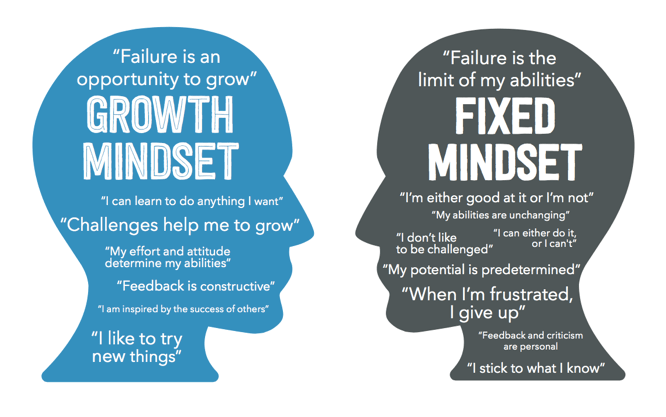
Introduction to Mindsets
Imagine walking into a room filled with potential, where every challenge is an opportunity waiting to unfold. Now picture the two distinct reactions people might have in that same space. One group sees obstacles as barriers, while another views them as stepping stones toward growth. This simple contrast highlights a powerful concept: mindsets.
Our beliefs shape how we perceive learning and our capacity to embrace challenges. At the heart of this discussion are two contrasting perspectives—the fixed mindset and the growth mindset. Understanding these can profoundly impact your personal development, success at work, and overall approach to life’s hurdles.
Are you ready to explore how your mindset influences your journey? Let’s dive deeper into these transformative beliefs and see how they affect not just learning but every aspect of life!

What is a Fixed Mindset?
A fixed mindset is the belief that abilities and intelligence are static traits. People with this mindset often think that their qualities are set in stone, leading to a fear of failure.
When faced with challenges, they may shy away instead of embracing opportunities for growth. This avoidance can hinder personal development and limit potential.
For those who subscribe to a fixed mindset, criticism feels like an attack on their identity rather than constructive feedback. As a result, learning becomes stunted as they resist change.
These beliefs create barriers not just in academics but also in professional settings. A reluctance to take risks or try new approaches can lead to stagnation.
In essence, individuals with a fixed mindset may find themselves trapped by their own limitations, unable to see the vast possibilities for improvement and success around them.
The Dangers of a Fixed Mindset
A fixed mindset can limit potential in profound ways. When individuals believe their abilities are set in stone, they often shy away from challenges. This avoidance stunts growth and learning.
Fear of failure becomes a constant companion. Instead of seeing setbacks as opportunities, they interpret them as reflections of their worth. This fear can lead to anxiety and a reluctance to engage fully in tasks.
Moreover, criticism is taken personally rather than constructively. A fixed mindset prompts defensiveness instead of openness to feedback. As a result, valuable lessons go unlearned.
Collaboration suffers too. Those with this mindset may see others’ successes as threats rather than inspiration or motivation.
The impact on relationships can be significant as well; jealousy and competition overshadow support and camaraderie among peers. In environments where collaboration thrives, those with a rigid outlook might feel isolated or demoralized.
What is a Growth Mindset?
A growth mindset is the belief that abilities and intelligence can be developed through dedication and hard work. This perspective fosters resilience, encouraging individuals to embrace challenges rather than shy away from them.
People with a growth mindset view failures as opportunities for learning. They understand that setbacks are part of the journey toward mastery. Instead of feeling defeated, they ask questions and seek solutions.
This belief nurtures curiosity. It propels individuals to explore new skills and ideas without fear of judgment or failure. A growth mindset creates an environment ripe for innovation and creativity.
In relationships, this mindset encourages open communication and collaboration. Individuals become more inclined to support one another in overcoming obstacles, building stronger connections along the way.

Benefits of a Growth Mindset
A growth mindset opens doors to endless possibilities. When you believe that your abilities can improve through effort and learning, every challenge becomes an opportunity.
People with a growth mindset tend to embrace obstacles rather than shy away from them. They see setbacks as stepping stones to success, which fosters resilience. This adaptability is crucial in both personal and professional environments.
Moreover, a growth mindset enhances creativity. The willingness to experiment without fear of failure leads to innovative solutions and fresh ideas.
Collaborative efforts thrive in this atmosphere as well; individuals are more likely to seek feedback and support from others when they view learning as a shared journey.
Embracing a growth mindset nurtures lifelong learning habits. It encourages exploration beyond comfort zones, ultimately enriching one’s knowledge base and skill set throughout life.
How to Develop and Maintain a Growth Mindset
To cultivate a growth mindset, start by embracing challenges. View them as opportunities to learn rather than obstacles.
Next, shift your self-talk. Replace negative thoughts with positive affirmations. Instead of saying, “I can’t do this,” try “I can improve with practice.”
Surround yourself with supportive individuals who inspire and motivate you. Their belief in your potential can be contagious.
Seek feedback actively and use it constructively. Critiques are valuable tools for growth, not personal attacks.
Set achievable goals that encourage progress over perfection. Celebrate small victories along the way; they keep motivation levels high.
Stay curious and open to new experiences. Lifelong learning is key to maintaining a growth mindset in all aspects of life. Embrace the journey—it’s just as important as the destination!
Applying a Growth Mindset in Education, Work, and Life
Applying a growth mindset can transform various aspects of your life. In education, it encourages students to embrace challenges and see mistakes as learning opportunities. This shift fosters resilience and boosts academic performance.
In the workplace, individuals who adopt a growth mindset are more likely to pursue professional development. They welcome feedback, seek new responsibilities, and collaborate with others to enhance their skills.
Life outside of work also benefits from this perspective. Embracing challenges in personal relationships or hobbies allows for deeper connections and more fulfilling experiences.
Cultivating curiosity becomes essential; asking questions leads to discovery and innovation. A positive attitude toward setbacks enables you to bounce back stronger than before.
Living with a growth mindset enriches every facet of existence, making each day an opportunity for improvement and success.

Conclusion
The beliefs we hold about ourselves and our abilities shape how we approach challenges. Understanding the difference between a growth mindset and a fixed mindset can drastically change the way we learn and grow.
With a fixed mindset, individuals often see their talents as static. This limits potential and stifles creativity. Instead of striving for improvement, they may avoid risks or new experiences due to fear of failure.
Conversely, embracing a growth mindset opens doors to exploration. It encourages resilience in the face of setbacks and fosters an environment where learning is valued over perfection. People with this outlook tend to be more adaptable, innovative, and better equipped to tackle life’s challenges.
Developing a growth mindset involves consistent effort. It’s about shifting your internal dialogue from “I can’t” to “I can learn.” Seeking feedback, celebrating small wins, and viewing obstacles as opportunities are essential steps in this journey.
Applying these principles goes beyond personal development; it influences education systems, workplace cultures, and everyday interactions. By nurturing a growth-oriented perspective in various aspects of life, individuals set themselves up for continuous improvement.
Recognizing how your beliefs impact learning is key to unlocking your fullest potential. Choosing to cultivate a growth mindset not only enriches personal experience but also empowers those around you on their own paths toward success.



Leave a Reply